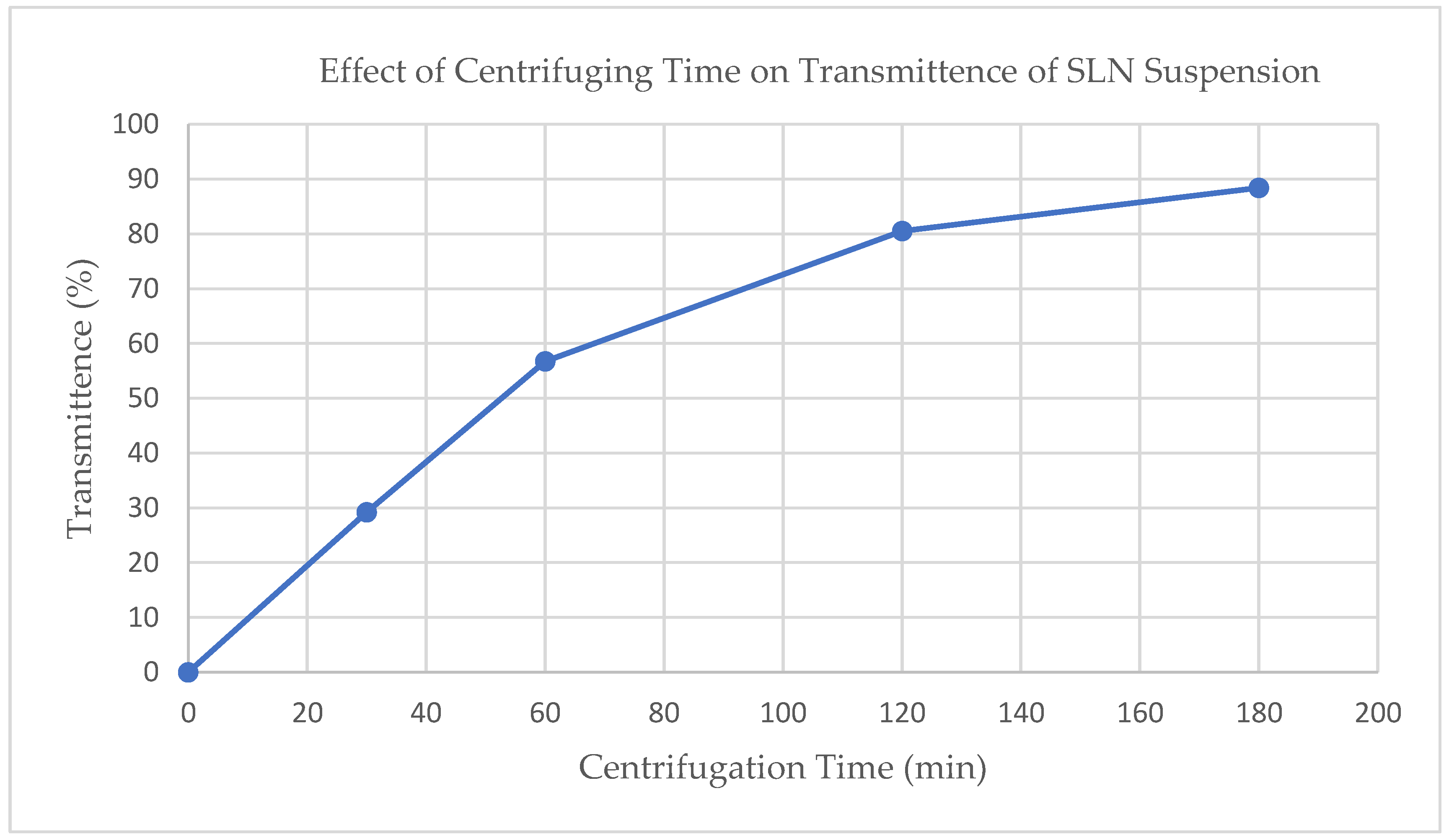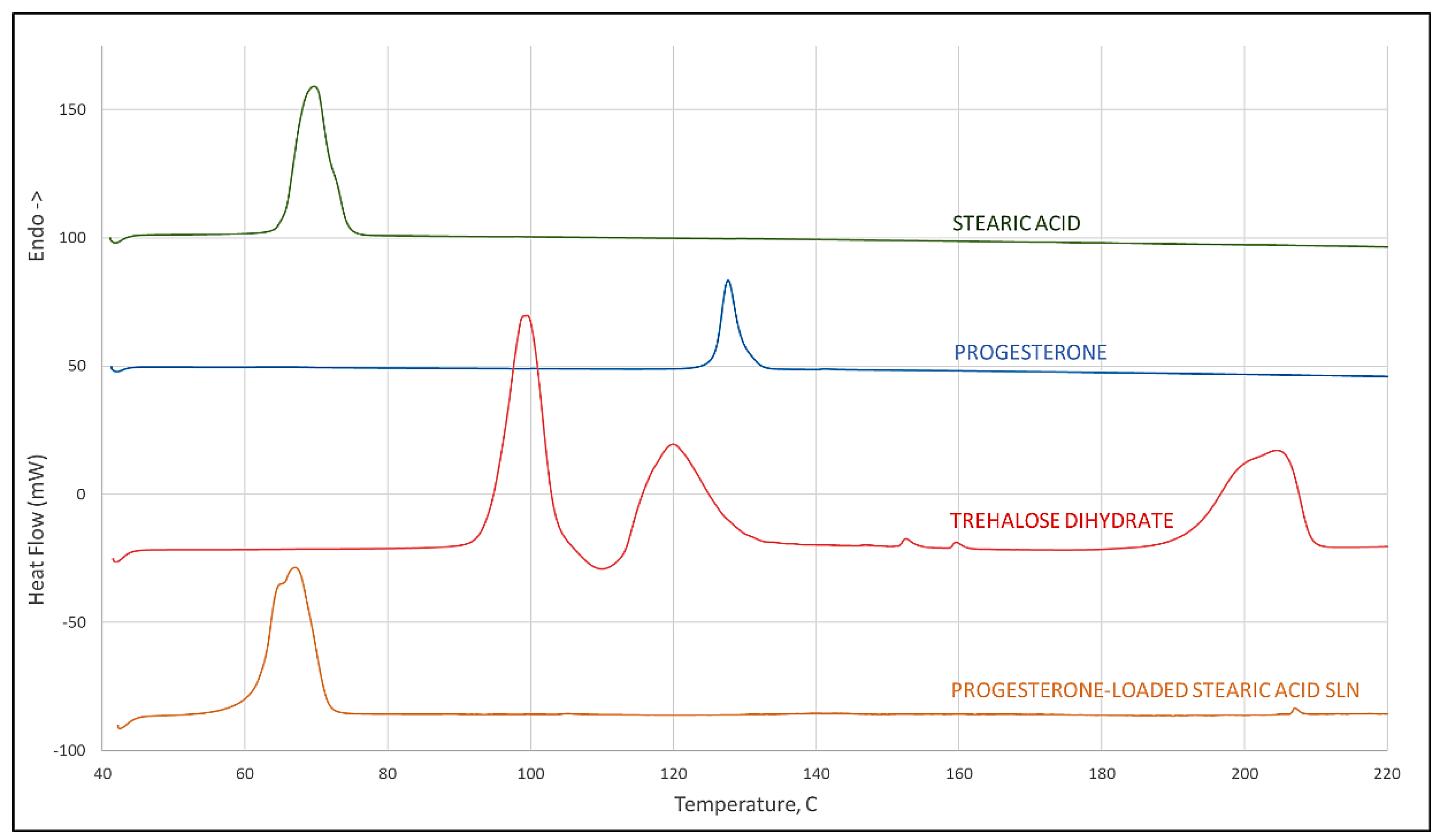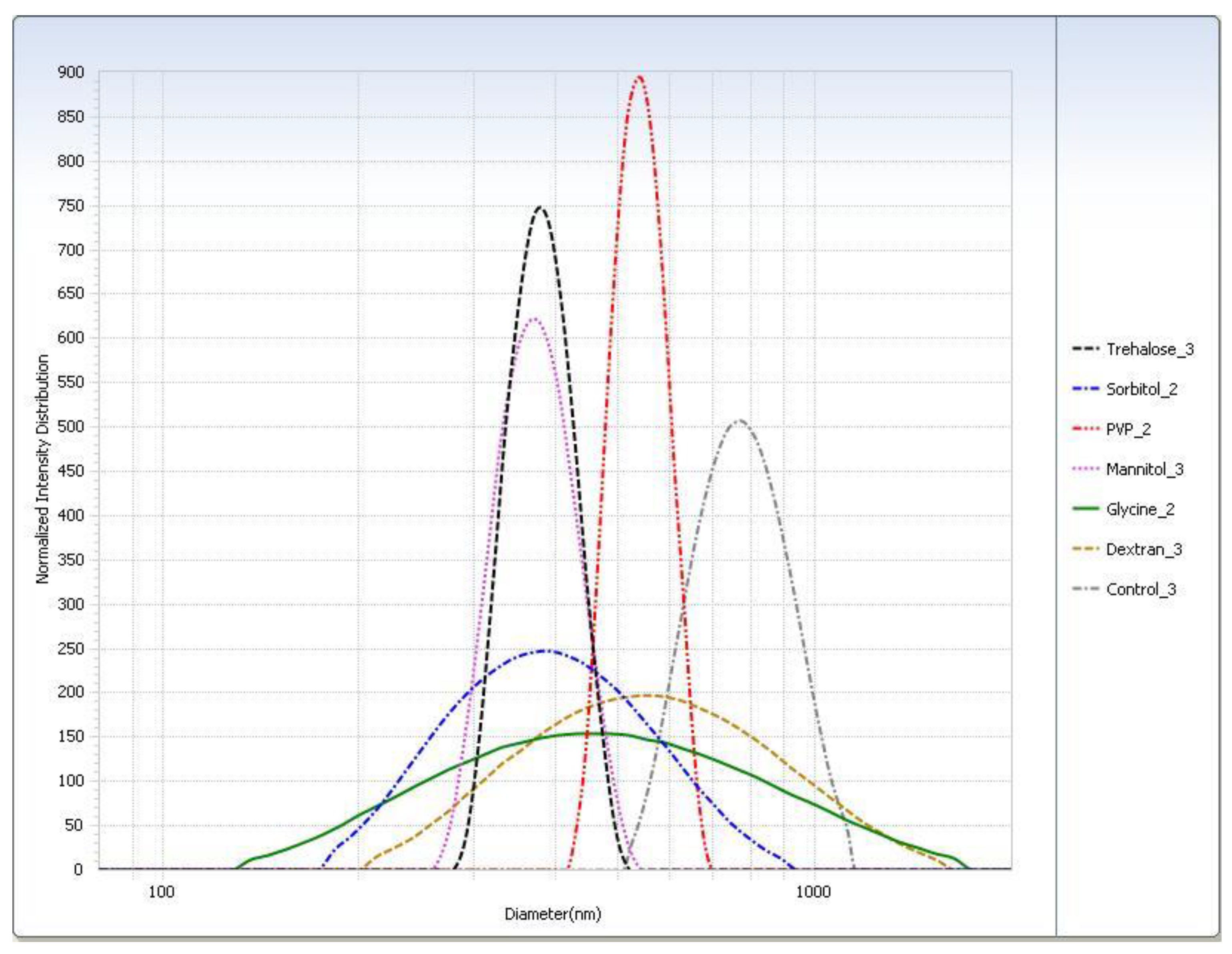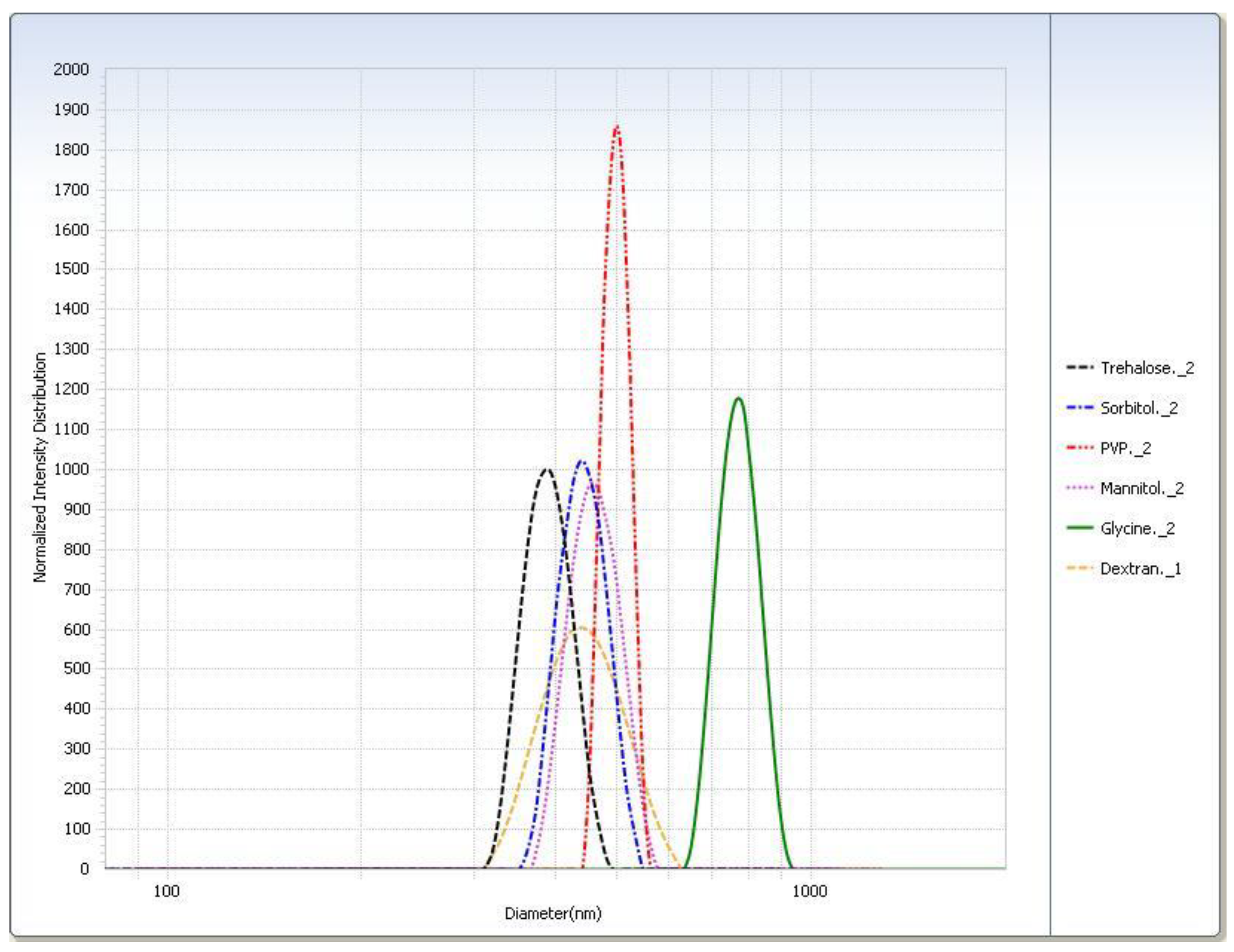Selection of Cryoprotectant in Lyophilization of Progesterone-Loaded Stearic Acid Solid Lipid Nanoparticles
Abstract
:1. Introduction
2. Materials
3. Methods
3.1. Progesterone Solubility in SA
3.2. Determination of Particle Size, Polydispersity Index and Zeta-Potential
3.3. Screening of Surfactants
3.4. Formulation of Progesterone Loaded Stearic Acid Solid Lipid Nanoparticles
3.4.1. Ultracentrifugation and Optimization
3.4.2. Particle Washing
3.5. Selection of Cryoprotectant
3.6. Optimization of Cryoprotectant Concentration
3.7. Lyophilization
3.8. Determination of Entrapment Efficiency and Drug Loading
3.9. HPLC Analysis and Sample Preparation
3.9.1. HPLC Conditions
3.9.2. Sample Preparation
3.10. Differential Scanning Calorimetry
3.11. Polarized Light Microscopy
3.12. Short Term Stability of Progesterone-Loaded SLNs Formulated with 20% Trehalose
4. Results and Discussion
4.1. Progesterone Solubility in SA
4.2. Selection of Surfactants and Concentration
4.3. Ultracentrifugation Optimization
4.4. Determination of Entrapment Efficiency and Drug Loading
4.5. Differential Scanning Calorimetry
4.6. Polarized Light Microscopy
4.7. Effect of Lyophilization on Progesterone-Loaded SLNs
4.7.1. Selection of Cryoprotectant
4.7.2. Optimization of Cryoprotectant Concentration
4.7.3. Mechanisms of Trehalose Cryoprotection
4.8. Short Term Stability of Progesterone-Loaded SLNs Formulated with 20% Trehalose
5. Conclusions
Author Contributions
Funding
Acknowledgments
Conflicts of Interest
References
- Mehnert, W.; Mäder, K. Solid lipid nanoparticles: Production, characterization and applications. Adv. Drug Deliv. Rev. 2001, 47, 165–196. [Google Scholar] [CrossRef]
- Hu, F.Q.; Hong, Y.; Yuan, H. Preparation and characterization of solid lipid nanoparticles containing peptide. Int. J. Pharm. 2004, 273, 29–35. [Google Scholar] [CrossRef]
- Mukherjee, S.; Ray, S.; Thakur, R.S. Solid lipid nanoparticles: A modern formulation approach in drug delivery system. Indian J. Pharm. Sci. 2009, 71, 349–358. [Google Scholar] [CrossRef] [Green Version]
- Talegaonkar, S.; Bhattacharyya, A. Potential of Lipid Nanoparticles (SLNs and NLCs) in Enhancing Oral Bioavailability of Drugs with Poor Intestinal Permeability. AAPS PharmSciTech. 2019, 20, 121. [Google Scholar] [CrossRef]
- Danaei, M.; Dehghankhold, M.; Ataei, S.; Davarani, F.H.; Javanmard, R.; Dokhani, A.; Khorasani, S.; Mozafari, M.R. Impact of Particle Size and Polydispersity Index on the Clinical Applications of Lipidic Nanocarrier Systems. Pharmaceutics 2018, 10, 57. [Google Scholar] [CrossRef] [Green Version]
- Shah, R.; Eldridge, D.; Palombo, E.; Harding, I. Production Techniques. In Lipid Nanoparticles: Production Characterisation and Stability; Springer International Publishing: Cham, Switzerland, 2015; pp. 23–43. [Google Scholar] [CrossRef]
- Shah, R.; Eldridge, D.; Palombo, E.; Harding, I. Composition and Structure. In Lipid Nanoparticles: Production, Characterization and Stability; Shah, R., Eldridge, D., Palombo, E., Harding, I., Eds.; Springer International Publishing: Cham, Switzerland, 2015; pp. 11–22. [Google Scholar] [CrossRef]
- Mishra, V.; Bansal, K.K.; Verma, A.; Yadav, N.; Thakur, S.; Sudhakar, K.; Rosenholm, J.M. Solid Lipid Nanoparticles: Emerging Colloidal Nano Drug Delivery Systems. Pharmaceutics 2018, 10, 191. [Google Scholar] [CrossRef] [Green Version]
- Gupta, S.; Kesarla, R.; Chotai, N.; Misra, A.; Omri, A. Systematic Approach for the Formulation and Optimization of Solid Lipid Nanoparticles of Efavirenz by High Pressure Homogenization Using Design of Experiments for Brain Targeting and Enhanced Bioavailability. Biomed Res. Int. 2017, 2017, 5984014. [Google Scholar] [CrossRef]
- Rubiano, S.; Echeverri, J.D.; Salamanca, C.H. Solid Lipid Nanoparticles (SLNs) with Potential as Cosmetic Hair Formulations Made from Otoba Wax and Ultrahigh Pressure Homogenization. Cosmetics 2020, 7, 42. [Google Scholar] [CrossRef]
- Rostamkalaei, S.S.; Akbari, J.; Saeedi, M.; Morteza-Semnani, K.; Nokhodchi, A. Topical gel of Metformin solid lipid nanoparticles: A hopeful promise as a dermal delivery system. Colloids Surf. B Biointerfaces 2019, 175, 150–157. [Google Scholar] [CrossRef]
- Abdelwahed, W.; Degobert, G.; Stainmesse, S.; Fessi, H. Freeze-drying of nanoparticles: Formulation, process and storage considerations. Adv. Drug Deliv. Rev. 2006, 58, 1688–1713. [Google Scholar] [CrossRef]
- Schwarz, C.; Mehnert, W. Freeze-drying of drug-free and drug-loaded solid lipid nanoparticles (SLN). Int. J. Pharm. 1997, 157, 171–179. [Google Scholar] [CrossRef]
- Franzé, S.; Selmin, F.; Samaritani, E.; Minghetti, P.; Cilurzo, F. Lyophilization of Liposomal Formulations: Still Necessary, Still Challenging. Pharmaceutics 2018, 10, 139. [Google Scholar] [CrossRef] [Green Version]
- Sakurai, M.; Furuki, T.; Akao, K.-I.; Tanaka, D.; Nakahara, Y.; Kikawada, T.; Watanabe, M.; Okuda, T. Vitrification is essential for anhydrobiosis in an African chironomid, Polypedilum vanderplanki. Proc. Natl. Acad. Sci. USA 2008, 105, 5093–5098. [Google Scholar] [CrossRef] [Green Version]
- Abdelwahed, W.; Degobert, G.; Fessi, H. Investigation of nanocapsules stabilization by amorphous excipients during freeze-drying and storage. Eur. J. Pharm. Biopharm. 2006, 63, 87–94. [Google Scholar] [CrossRef]
- Allison, S.D.; Molina, M.d.; Anchordoquy, J.T. Stabilization of lipid/DNA complexes during the freezing step of the lyophilization process: The particle isolation hypothesis. Biochim. Biophys. Acta Biomembr. 2000, 1468, 127–138. [Google Scholar] [CrossRef] [Green Version]
- Pereira, G.R.; Marchetti, J.M.; Bentley, M.V.L.B. A Rapid Method for Determination of Progesterone By Reversed-Phase Liquid Chromatography from Aqueous Media. Anal. Lett. 2000, 33, 881–889. [Google Scholar] [CrossRef]
- Freitas, C.; Müller, R.H. Effect of light and temperature on zeta potential and physical stability in solid lipid nanoparticle (SLNTM) dispersions. Int. J. Pharm. 1998, 168, 221–229. [Google Scholar] [CrossRef]
- Azizi, E.; Namazi, A.; Haririan, I.; Fouladdel, S.; Khoshayand, M.R.; Shotorbani, P.Y.; Nomani, A.; Gazori, T. Release profile and stability evaluation of optimized chitosan/alginate nanoparticles as EGFR antisense vector. Int. J. Nanomedicine 2010, 5, 455–461. [Google Scholar] [CrossRef] [Green Version]
- Allan, M.; Chamberlain, M.C.; Mauer, L.J. RH-Temperature Stability Diagram of the Dihydrate, β-Anhydrate, and α-Anhydrate Forms of Crystalline Trehalose. J. Food Sci. 2019, 84, 1465–1476. [Google Scholar] [CrossRef]
- Borges, O.; Borchard, G.; Verhoef, J.C.; de Sousa, A.; Junginger, H.E. Preparation of coated nanoparticles for a new mucosal vaccine delivery system. Int. J. Pharm. 2005, 299, 155–166. [Google Scholar] [CrossRef] [Green Version]
- Sundaramurthi, P.; Suryanarayanan, R. Trehalose Crystallization During Freeze-Drying: Implications On Lyoprotection. J. Phys. Chem. Lett. 2010, 1, 510–514. [Google Scholar] [CrossRef]
- van der Sman, R.G.M. Phase field simulations of ice crystal growth in sugar solutions. Int. J. Heat Mass Transf. 2016, 95, 153–161. [Google Scholar] [CrossRef]
- Roe, K.D.; Labuza, T.P. Glass Transition and Crystallization of Amorphous Trehalose-sucrose Mixtures. Int. J. Food Prop. 2005, 8, 559–574. [Google Scholar] [CrossRef]
- Green, J.L.; Angell, C.A. Phase relations and vitrification in saccharide-water solutions and the trehalose anomaly. J. Phys. Chem. 1989, 93, 2880–2882. [Google Scholar] [CrossRef]





| Surfactant (0.5%) | Particle Size Mean (SD) (nm) | PI Mean (SD) | Zeta Potential Mean (SD) (mV) |
|---|---|---|---|
| Sodium taurocholate (0.25%) and Lecithin (0.25%) | 315.2 (5.534) | 0.001937 (0.000259) | −43.26 (1.44) |
| Poloxamer 188 | 319.6 (6.951) | 0.005854 (0.004919) | −10.18 (3.67) |
| Kolliphor RH 40 | 374.0 (8.693) | 0.02158 (0.01198) | −17.76 (5.58) |
| Tween 80 | 346.4 (3.988) | 0.08224 (0.04563) | 1.24 (1.29) |
| Surfactant Concentration (%) | Particle Size Mean (SD) (nm) | PI Mean (SD) | Zeta Potential (mV) Mean (SD) |
|---|---|---|---|
| 0.5 | 315.2 (5.534) | 0.001937 (0.000259) | −43.26 (1.44) |
| 1 | 397.6 (10.70) | 0.027603 (0021363) | −32.68 (2.16) |
| 2 | 385.7 (0.07506) | 0.002161 (0.00000567) | −45.52 (1.22) |
| Sample (−20 °C/Slow Freeze) | Particle Size Mean (SD) (nm) | PI Mean (SD) | Sample (−70 °C /Rapid Freeze) | Particle Size Mean (SD) (nm) | PI Mean (SD) |
|---|---|---|---|---|---|
| Control | 726.5 (106.5) | 0.023 (0.0050) | Control | 596.5 (28.60) | 0.00287 (0.000415) |
| Dextran | 514.9 (8.822) | 0.103 (0.0787) | Dextran | 487.6 (25.75) | 0.00460 (0.00201) |
| Glycine | 431.7 (5.493) | 0.217 (0.157) | Glycine | 355.2 (14.25) | 0.0102 (0.00674) |
| Mannitol | 379.1 (6.213) | 0.014 (0.00388) | Mannitol | 381.1 (13.71) | 0.00924 (0.00361) |
| PVP | 528.6 (45.92) | 0.0012 (0.00792) | PVP | 513.7 (38.48) | 0.00757 (0.00467) |
| Sorbitol | 374.6 (14.70) | 0.102 (0.0833) | Sorbitol | 360.4 (19.07) | 0.0119 (0.00737) |
| Trehalose | 374.1 (8.100) | 0.0265 (0.0193) | Trehalose | 358.8 (3.821) | 0.0652 (0.0618) |
| Sample | Redispersion Quality |
|---|---|
| Control 20 | 3 |
| Dextran 20 | 1 |
| Glycine 20 | 1 |
| Mannitol 20 | 1 |
| PVP 20 | 2 |
| Sorbitol 20 | 1 |
| Trehalose 20 | 1 |
| Control 70 | 3 |
| Dextran 70 | 1 |
| Glycine 70 | 1 |
| Mannitol 70 | 1 |
| PVP 70 | 1 |
| Sorbitol 70 | 1 |
| Trehalose 70 | 1 |
| Sample (−20 °C /Slow Freeze) | Particle Size Mean (SD) (nm) | PI Mean (SD) | Sample (−70 °C /Rapid Freeze) | Particle Size Mean (SD) (nm) | PI Mean (SD) |
|---|---|---|---|---|---|
| Control * | - | - | Control * | - | - |
| Dextran | 466.2 (14.84) | 0.044 (0.033) | Dextran | 445.8 (19.08) | 0.0026 (0.00067) |
| Glycine | 930.6 (102.6) | 0.0062 (0.0044) | Glycine | 1292.2 | 0.0062 (0.000089) |
| Mannitol | 523.2 (34.79) | 0.0077 (0.00049) | Mannitol | 705.9 | 0.0027 (0.00043) |
| PVP | 537.8 (37.35) | 0.0026 (0.00061) | PVP | 488.0 | 0.0026 (0.00050) |
| Sorbitol | 448.2 (13.04) | 0.00037 (0.00026) | Sorbitol | 420.5 | 0.0044 (0.0011) |
| Trehalose | 374.0 (8.100) | 0.0063 (00036) | Trehalose | 397.2 | 0.0035 (0.0022) |
| Sample | Redispersion Quality |
|---|---|
| Control 20 | 3 |
| Dextran 20 | 1 |
| Glycine 20 | 1 |
| Mannitol 20 | 1 |
| PVP 20 | 2 |
| Sorbitol 20 | 1 |
| Trehalose 20 | 1 |
| Control 70 | 3 |
| Dextran 70 | 1 |
| Glycine 70 | 1 |
| Mannitol 70 | 1 |
| PVP 70 | 1 |
| Sorbitol 70 | 1 |
| Trehalose 70 | 1 |
| Percent Trehalose | Redispersion Quality |
|---|---|
| 0% | 3 |
| 5% | 1 |
| 10% | 1 |
| 15% | 1 |
| 20% | 1 |
| Percent Trehalose | Particle Size Mean (SD) (nm) | PI Mean (SD) |
|---|---|---|
| 0% | Unable to redisperse | Unable to redisperse |
| 5% | 376.7 (4.371) | 0.044 (0.022) |
| 10% | 361.6 (5.412) | 0.027 (0.0072) |
| 15% | 374.1 (14.76) | 0.11 (0.066) |
| 20% | 332.5 (10.65) | 0.0061 (0.0021) |
| Storage Time | Mean Assay, % Progesterone w/w (N = 2) | Particle Size Mean (SD) (nm) | PI Mean (SD) | Redispersibility |
|---|---|---|---|---|
| Initial | 1.97 | 319.8 (1.762) | 0.0044 (0.0035) | 1 |
| 25 °C/50% RH | ||||
| 2 weeks | 1.94 | 667.7 (65.47) | 0.0059 (0.0059) | 1 |
| 4 weeks | 1.85 | 531.0 (19.92) | 0.15 (0.12) | 1 |
| 40 °C/25% RH | ||||
| 1 week | 1.42 | 425.6 (13.42) | 0.0081 (0.0046) | 1 |
| 2 weeks | 1.44 | 663.9 (21.80) | 0.010 (0.0076) | 1 |
| 4 weeks | 1.45 | 695.3 (32.66) | 0.57 (0.27) | 1 |
© 2020 by the authors. Licensee MDPI, Basel, Switzerland. This article is an open access article distributed under the terms and conditions of the Creative Commons Attribution (CC BY) license (http://creativecommons.org/licenses/by/4.0/).
Share and Cite
Amis, T.M.; Renukuntla, J.; Bolla, P.K.; Clark, B.A. Selection of Cryoprotectant in Lyophilization of Progesterone-Loaded Stearic Acid Solid Lipid Nanoparticles. Pharmaceutics 2020, 12, 892. https://doi.org/10.3390/pharmaceutics12090892
Amis TM, Renukuntla J, Bolla PK, Clark BA. Selection of Cryoprotectant in Lyophilization of Progesterone-Loaded Stearic Acid Solid Lipid Nanoparticles. Pharmaceutics. 2020; 12(9):892. https://doi.org/10.3390/pharmaceutics12090892
Chicago/Turabian StyleAmis, Timothy M., Jwala Renukuntla, Pradeep Kumar Bolla, and Bradley A. Clark. 2020. "Selection of Cryoprotectant in Lyophilization of Progesterone-Loaded Stearic Acid Solid Lipid Nanoparticles" Pharmaceutics 12, no. 9: 892. https://doi.org/10.3390/pharmaceutics12090892






